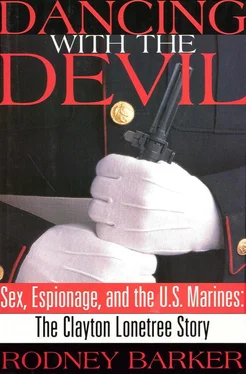Much later, when NIS investigators would interview embassy employees, they would be given a tawdry portrait of Violetta that would support the impression she was on the make. “While an employee at the General Services office, she visibly spent much time doing her fingernails, reading trashy English novels, and displaying a brazen lack of interest in her job,” they would be told. “She made overt eye and facial expressions indicative of a sexual approach… and her frequent attempts to physically lure American personnel became an office joke. Coworkers referred to her as ‘the dangle.’ ” Some even assessed her as an individual who attempted to make herself attractive to either sex.
It’s hard to know what to make of these observations, because the way Violetta told it to her mother, numerous Marines made passes at her while she worked at the embassy, but she wasn’t interested. At least one political officer became a nuisance, calling her at home and inviting her to dinner and embassy functions, until finally she told her mother to refuse his calls. And when she first noticed Clayton Lonetree following her home from work, she was convinced he was a CIA agent, which was what she told the KGB when she called to report on him.
• • •
By the time Violetta made her call, Sgt. Clayton Lonetree was already under KGB observation. The Second Chief Directorate of the KGB was the Soviet counterpart to the FBI, its specialty internal counterintelligence, and to fulfill its charter it was divided into twelve departments. Because America was perceived as the primary enemy, the First Department directed its interest and activities toward the American Embassy and its personnel. On staff at the First Department was a chief; several deputies; about fifty staff officers, recruiters, and agent handlers; and several hundred professional surveillants who did nothing but follow people who came out of the American Embassy. These were the people who first noticed Lonetree, and they had filed several reports on his bizarre activities. He left the compound by himself in violation of the rules they knew were laid down for Marine guards. He rode the metro miles beyond the travel limits they knew were specified.
Those who worked in surveillance were a laconic bunch, and when their shift was complete, they would regularly go out for coffee or vodka and grumble about what had been written in the daily newspaper. These days the conversation invariably returned to the American Marine and what he was up to. They couldn’t figure it out. The guy was breaking every rule in the Marine book, he was doing it all the time, and nothing was happening to him.
Within the First Department, whose headquarters were a half mile from the embassy in an unassuming five-story building, analysts considering the Marine guard’s behavior were asking the same questions, and came up with a theory. It was a commonly held belief at this time that the CIA group in the American Embassy was the most reckless and adventurous of all the intelligence offices attached to any of the embassies in Moscow. This was perceived to be a direct reflection of the personality of the CIA’s current director, William Casey, under whose leadership the CIA had been willing to take more than the usual number of risks to recruit human sources. They speculated the Marine might be some sort of crude bait in yet another provocative CIA scheme.
But after Violetta’s call the picture became slightly clearer: Perhaps it was nothing more than the matter of a Marine falling for a Russian beauty, and a lapse in security vigilance at the embassy.
The individual who initially handled the case was a recent graduate of KGB school, a young man who went by the name of “Slava” but whose real name was Vladimir Pavlovich Gerashchenko. Slava worked in a department of the KGB that took the reports from the Russian workers in foreign embassies, specifically the branch that concerned itself with the American Embassy. He was relatively inexperienced but he was also a go-getter, anxious to move up in rank. He knew that a big concern within Soviet counterintelligence throughout the eighties had been that it had very few agents in the embassies of the main capitalist states in the U.S.S.R., and that its inside work was carried out mainly by Soviet citizens employed by the embassies. Therefore the idea of recruiting someone from the “stronghold of the spies,” as the American Embassy was known, could lead to a rapid promotion, even if it was just a guard. As the Russian proverb said, “When there is no fish, a shrimp will do.”
After interviewing Violetta in his cubicle at headquarters, Slava reported the results to his superior, who in turn sent the report up the chain of command, where it arrived finally on the desk of Gen. Rem Krasil’nikov, head of the First Department. A slim, white-haired man in his late fifties with sparkling brown eyes, Krasil’nikov had earned his position by being a very good operational officer. He was reputed to have successfully recruited American agents, including several from the CIA, in Lebanon in the early seventies. Normally a report like this would have captured his full attention, but at that very moment the general was dealing with bigger issues. His officers had recently arrested a Soviet expert in stealth technology by the name of Adolf Tolkachev, caught in the act of passing secret documents to U.S. intelligence agent Paul Stombaugh, who was posing as a second secretary at the U.S. Embassy; and Krasil’nikov was then investigating a hot tip that a double agent was working in his department. So he did not take a special interest in Slava’s report. His response was “Stay on top of it. See what you can get out of it. Keep me informed.”
Even though his boss may have been nonchalant, Slava was thrilled and called Violetta back in. She seemed nervous to him and said she wanted to tell the Marine to leave her alone, but Slava told her just to keep on doing what she was doing and see what happened. Outdoor surveillance would keep an eye on the Marine so she would be safe, and she should contact him immediately if she was actually approached.
Slava knew that the best recruitment scenarios were the simplest and closest to life. He also knew the critical step in any recruitment was the initial contact, and it would be best to let the Marine make the first move.
In the meantime an order went out to expand the “recruitment dossier” on Sgt. Clayton Lonetree. A file of this sort was kept on virtually every person at the American Embassy—from the smallest child to the ambassador—as a matter of course. It included all the paperwork required by Soviet customs before entry into the Soviet Union was allowed; special applications embassy employees were required to submit; and the résumés and biographies of everyone were factually checked by researchers working in the Soviet residency in the States. In this file details that were relevant to the development of an individual recruitment plan were noted, and in those cases where a diplomat was suspected of being an intelligence agent, or a weak link was identified, a special investigation was undertaken.
The dossier on Lonetree was fat by the time Violetta reported that he had approached her on the metro. At this point she was not technically an agent, so she was given a standard statement to sign that read: “I, Violetta Seina, agree to voluntarily cooperate with the organs of the Soviet Committee for State Security, for the sake of combating enemies of the Soviet Union and for the purpose of strengthening state security….” It ended that she was not to divulge to anyone that she was working for the security services, and she understood the full consequences if she were to break faith with them. She was then put through a series of brief but intensive training sessions with sophisticated teachers from the intelligence schools, who instructed her on how she should conduct herself in this matter.
Читать дальше












